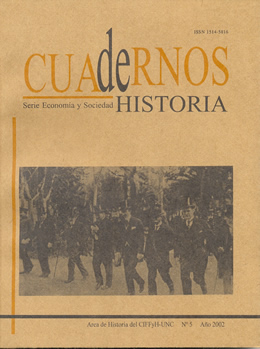Work from the psychiatric perspective. Between moral treatment and the problem of chronicity in the asylum of Oliva de Córdoba in the first decades of the 20th century
DOI:
https://doi.org/10.53872/2422.7544.n5.9904Abstract
What interests me here is the fact that the mental patient, especially the incurable chronic patient, perceived as a real problem from this perspective, will become, in general terms, the dilettante addressee of the psychiatric discourse on work. And from this centrality, we will subsequently investigate how the medical discourse will also slide other arguments, which open up to broader dimensions, and which, by way of reinforcement of its postulates, suggest the way to other interpretations. In this movement, around the 1930s, a social reading of the chronically mentally ill can be detected, which reveals an effort to conceptualize their position no longer from a strictly psychiatric conception but from a social-assistance one.
References
Alvarez, R; Huertas, R. y Peset J., 1993, “Enfermedad mental y sociedad en la Europa de la segunda mitad del siglo XIX.” En: Asclepio. Revista de Historia de la Medicina y de la Ciencia, Centro de Estudios Históricos del Consejo Superior de Investigaciones Científicas de Madrid, Vol. XLV-2- pp. 41-60.
Arendt, Hannah, 1993, La Condición Humana, Paidós, Barcelona.
Bercherie, Paul, 1993, Los fundamentos de la clínica. Historia y estructura del saber psiquiátrico, Manantial, Buenos Aires.
Castel, Robert, 1997, La metamorfosis de la cuestión social. Una crónica del salariado, Paidós, Buenos Aires.
Donzelot, Jaques, 1988, “Espacio cerrado, trabajo y moralización. Génesis y transformaciones paralelas de la prisión y del manicomio.” En: AA.VV., Espacios de poder, La Piqueta, Madrid.
Dörner, Klaus, 1974, Ciudadanos y Locos. Historia Social de la Psiquiatría, Taurus, Madrid.
Eraso, Yolanda, 1999, Trabajo Alienado. Aportes para la comprensión del trabajo de los enfermos mentales en una institución psiquiátrica pública: Asilo Colonia Regional Mixto de Alienados en Oliva (Pcia. de Córdoba) 1914-1934. Tesis de Licen- ciatura, mimeo, Universidad Nacional de Córdoba.
Foucault, Michel, 1967, Historia de la locura en la época clásica, Fondo de Cultura Económica, México.
Huertas, Rafael, 1988, “Asilos para locos: Terapéutica mental y política sanitaria.” En: Asclepio, Revista de Historia de la Medicina y de la Ciencia, Centro de Estudios Históricos del Consejo Superior de Investigaciones Científicas de Madrid, Vol. XL- 2, pp. 131-149.
Méda, Dominque, 1998, El trabajo. Un valor en peligro de extinción, Gedisa, Barcelona.
Offe, Claus, 1992, La sociedad del trabajo. Problemas estructurales y perspectivas de futuro, Alianza Universidad, Madrid.
Peset, José Luis, 1993, Las Heridas de la Ciencia, Junta de Castilla y León, Consejería de Cultura y Turismo, Salamanca.
Sontag, Susan, 1996, La enfermedad y sus metáforas y el sida y sus metáforas, Taurus, Buenos Aires.
Vezzetti, Hugo, 1985, La locura en la argentina, Paidós, Buenos Aires.
Vezzetti, Hugo, 1991, “Domingo Cabred y el asilo de puertas abiertas” En: Vertex, Revista argentina de psiquiatría, Vol.2, Nº3, marzo, abril, mayo de 1991, págs. 59- 61.
Downloads
Published
Issue
Section
License
Copyright (c) 2014 Cuadernos de historia. Serie Economía y Sociedad

This work is licensed under a Creative Commons Attribution 4.0 International License.
Authors publishing in this journal accept the following terms:
a. The author maintains their copyrights and grants this journal the publication of the first original version of their work that is subject to the Creative Commons Attribution License 4.0. This license agreement allows:
Sharing — copy and redistribution of the published material by any means and formats
Reusing — remix, change, and creation of new material from the published work for any purpose, including commercial use.
b. Authors may enter other non-exclusive license agreements of distribution of the version of the published work (i.e. uploading the material on an institutional virtual archive or republishing it on a monographic volume) as long as they attribute the publication of the original version to this journal.
c. It is allowed and recommended that authors publicize their work on the Internet (i.e. on institutional virtual archives or on their personal or professional websites) after their work has been published in this journal.




